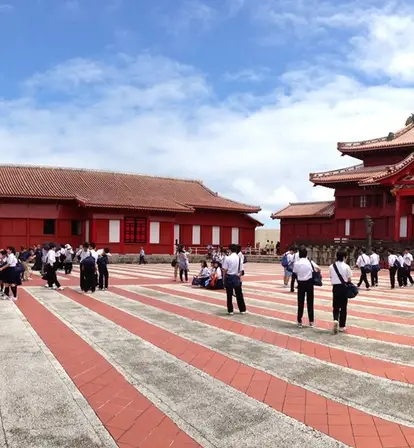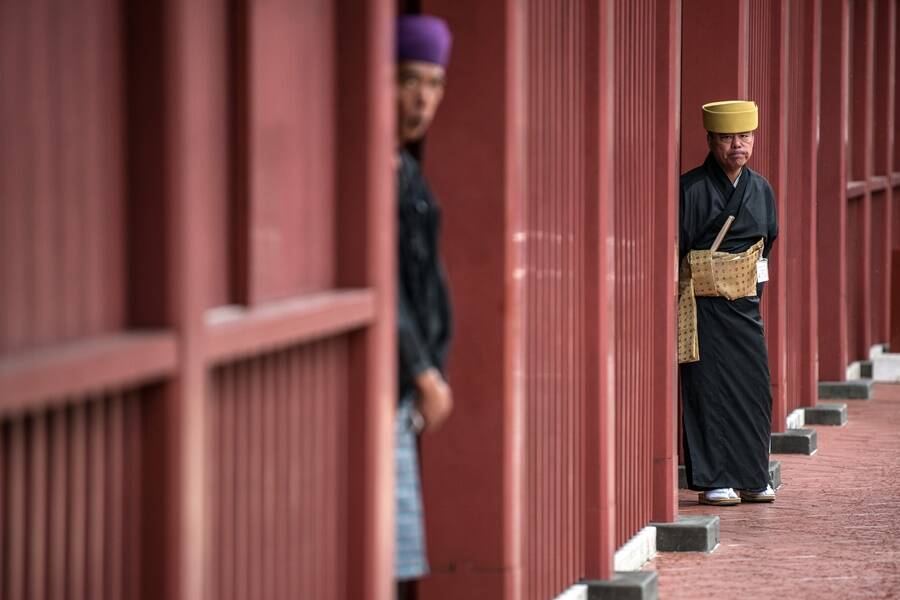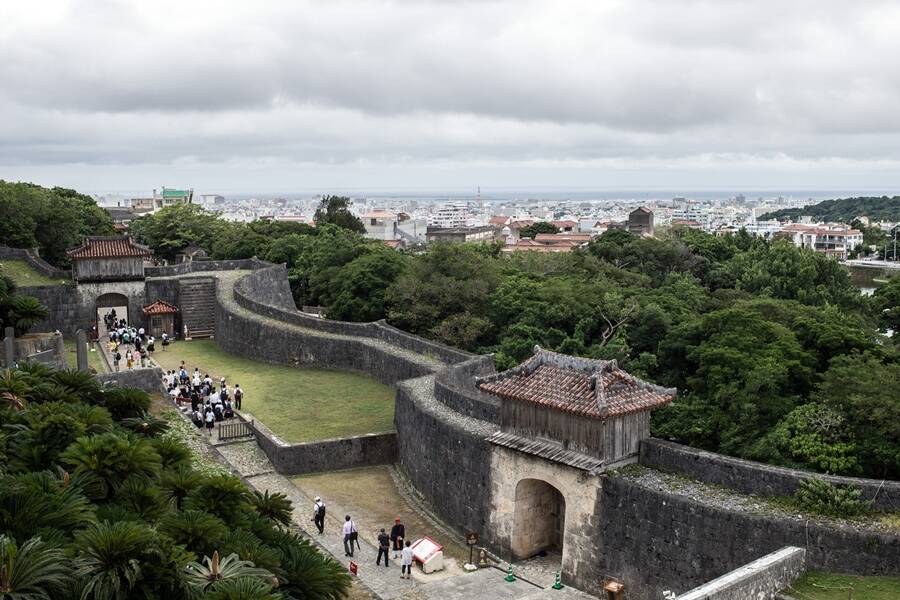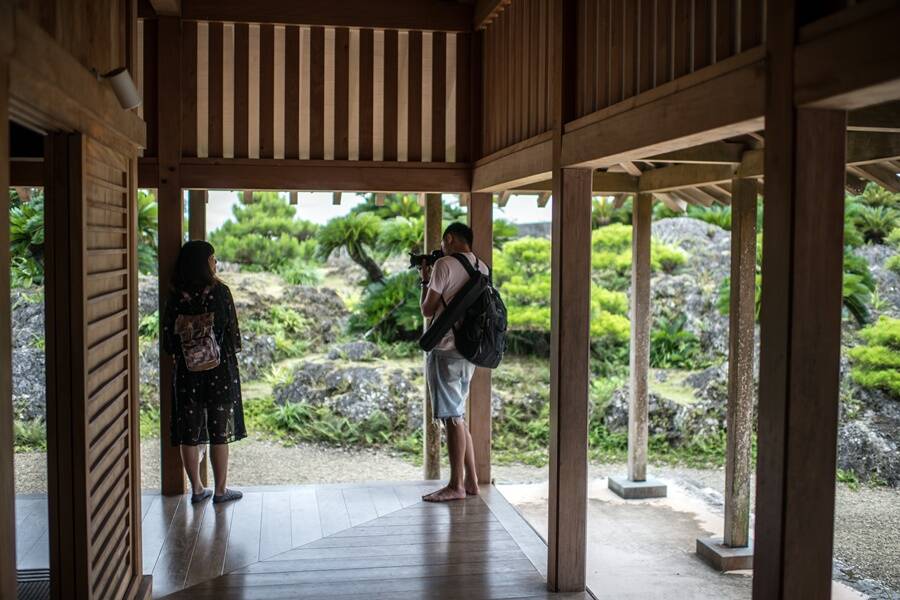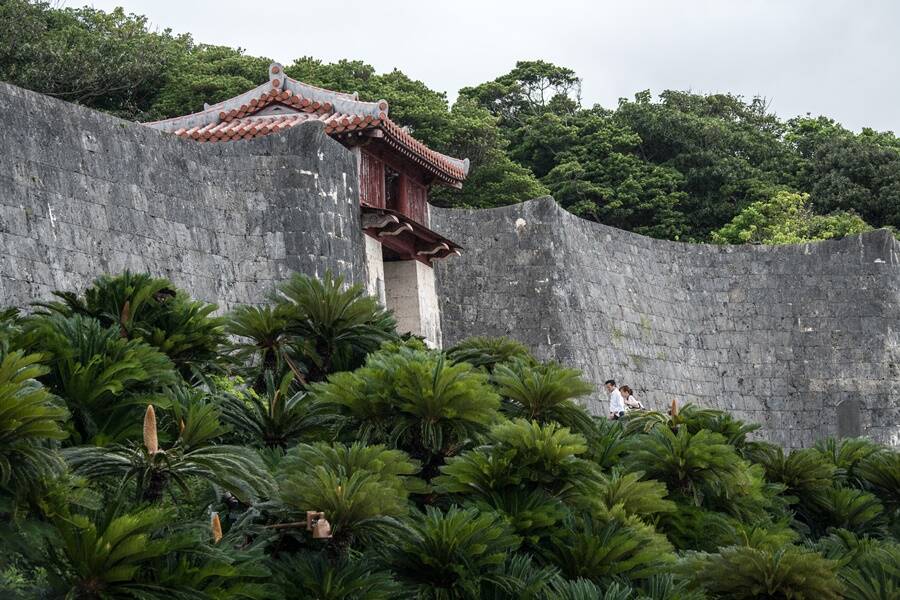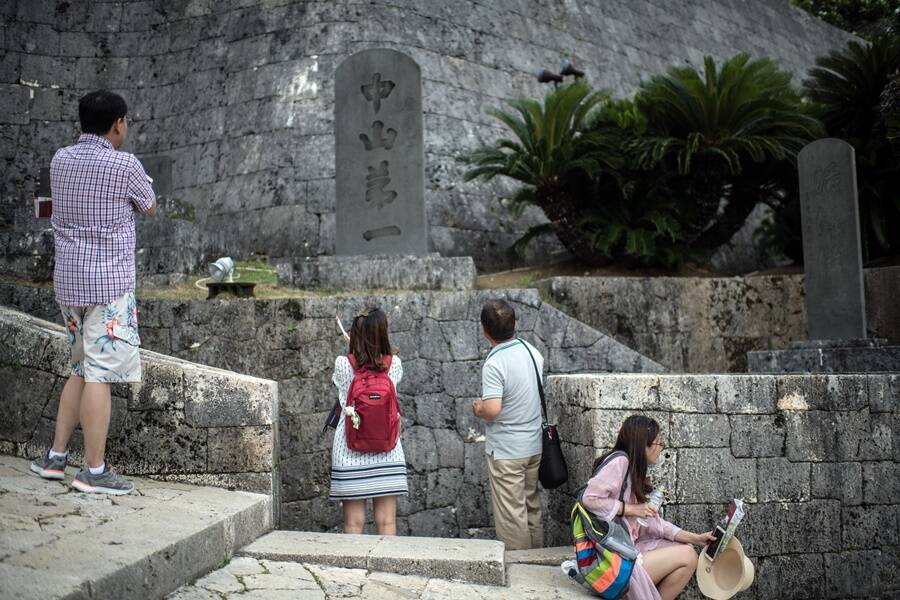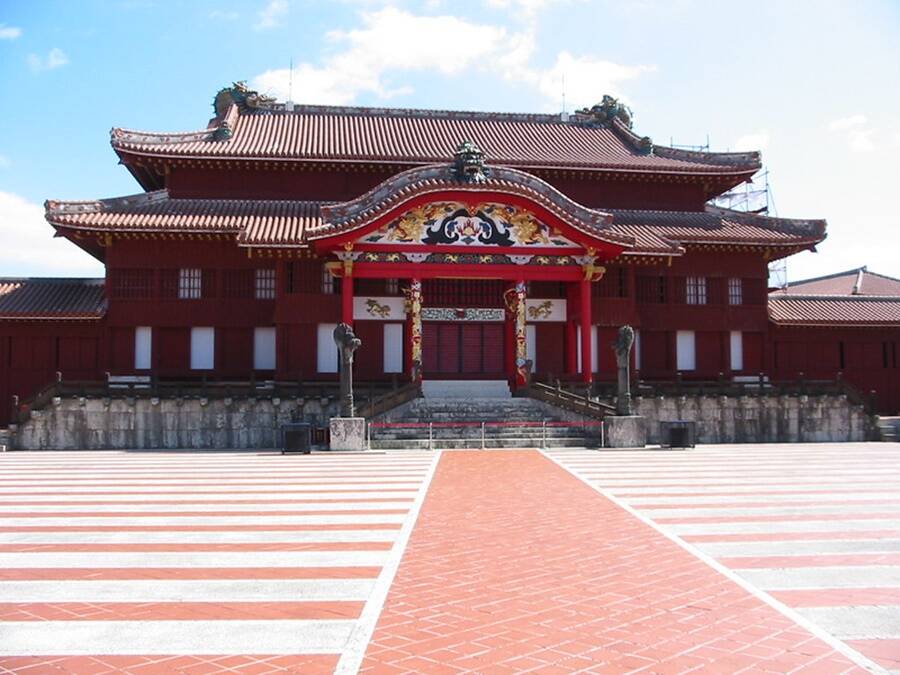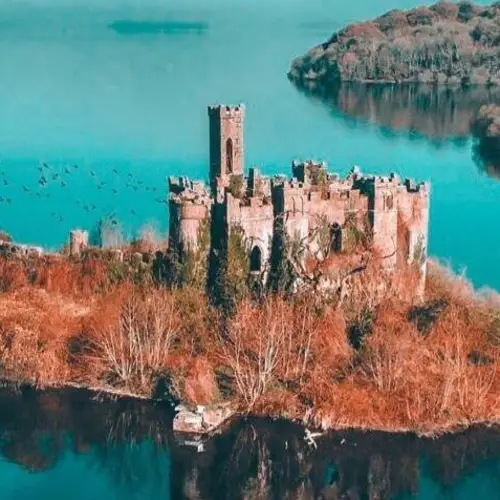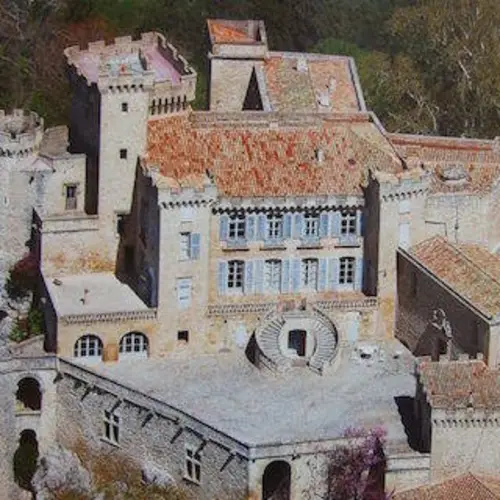Built more than 600 years ago, Okinawa's Shuri Castle has weathered World War II bombings and a devastating 2019 fire. Here's why it remains an iconic symbol of the Japanese island.
Constructed in the 14th century as the royal residence and center of activity of the Ryukyu Kingdom in Okinawa, Shuri Castle has endured several instances of destruction. Not even U.S. military attacks during the Battle of Okinawa and a devastating fire in 2019 could crumble this historic structure.
Today, it stands as an important World Heritage Site and a significant symbol of Okinawan pride.
A World Heritage Site Of Okinawa
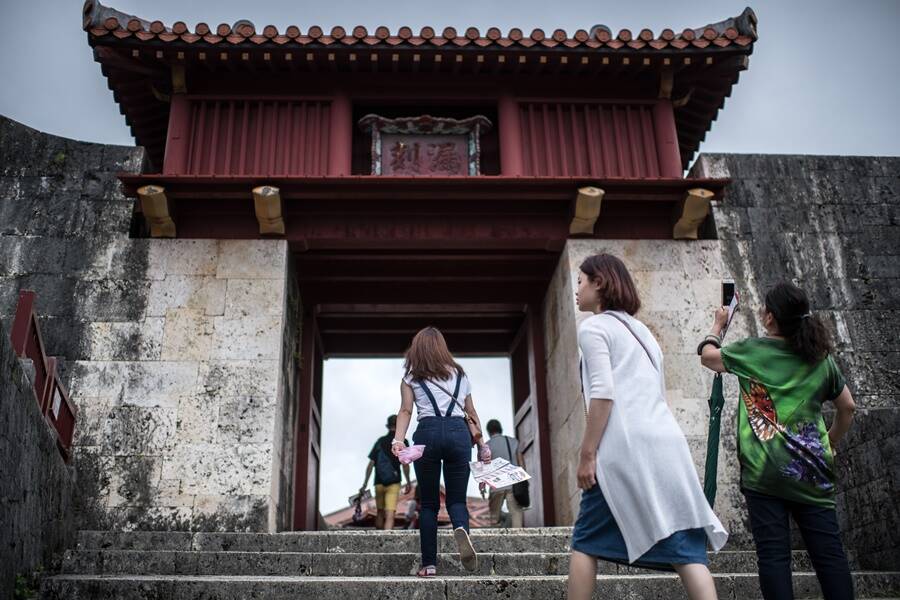
Carl Court/Getty ImagesThe historic site regularly draws about two million tourists to the island.
The design and architecture of Shuri Castle are quite different compared to other ancient castles found in the territory of Japan. For instance, the dragon figures and splashes of gold and red embedded in the walls signify the island's history with neighboring China.
Built inside a sprawling complex, Shuri Castle — or Shurijo Castle Park — includes layers of inner and outer walls constructed in different eras. The outer wall dates back to the 15th century and the inside wall dates back to the mid-16th century.
The castle has three separate areas: the living quarters, the central administration area, and ceremonial areas. The living quarters were occupied by the Ryukyu Kingdom's ruling family from 1429 to 1879.
The castle's main hall used to be the central building (Seiden) of the grounds. It was heavily guarded and located atop the hill beyond several gated entrances. The Una Plaza, or the courtyard area in front of the main hall, was accessible only to royals and noble kingdom members.
There are a number of architectural highlights at Shuri Castle. Among them the Kinjocho Ishidatamimichi, a beautiful stone pathway that snakes through its tree grove. Other notable sites include the Shurei-mon Gate, built by King Sho Sei in the early 16th century, and Sonohyan Utaki Ishimon, a stone gate entrance to the sacred grove.
The castle has incredibly survived for more than 500 years. But it has seen some damage throughout its history, particularly from U.S. military bombardment during World War II.
Over 500 Years Of History In The Okinawa Castle
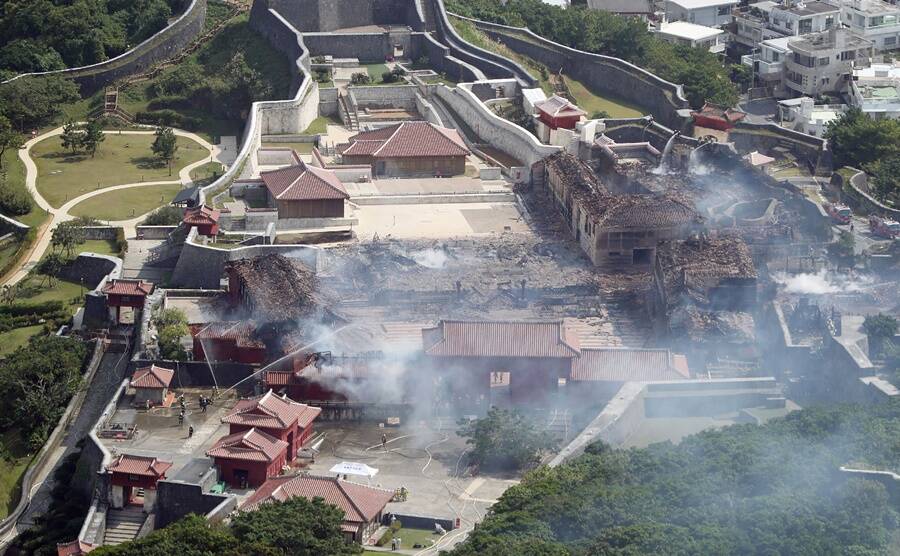
STR/JIJI PRESS/AFP via Getty ImagesThis aerial picture shows Shuri Castle after a fire ripped through the historic site in October 2019.
Shuri Castle's history is enmeshed in the imperialist history between the island of Okinawa and Japan, which annexed the Ryukyu Islands into its feudal domain in 1879. Before then, Shuri had been the capital of Okinawa. Now, the city is part of Naha, the new capital of Japan's Okinawa prefecture.
It's unclear when exactly Shuri Castle's construction took place. Historians place it sometime in the Sanzan Period (1322–1429), which overlapped with the Gusuku Period (1187–1429) when fortresses (gusuku) became commonly found across the region.
Before becoming a Japanese territory, the Ryukyu Kingdom flourished. The island territory of Okinawa united as a single nation ruled by King Sho Hashi during the first Sho Dynasty. The kingdom made trades and built diplomacies with countries like China, Japan, Korea, and several entities from Southeast Asia. Shuri Castle became the epicenter of the kingdom's political and economic growth.
After the Japanese took over the Ryukyu Islands in 1879, the castle was used as barracks for the Imperial Japanese Army starting in 1884. During this period, a series of tunnels and caverns were dug beneath the structure. The Army left the castle in 1896.
Shuri City bought the castle back from the Japanese government in 1908. Later, Shuri Castle's main hall was designated as a national treasure (kokuhō) by the state in 1925.
Shuri Castle endured serious damage in at least five occasions over the centuries. It was most heavily destroyed in the Battle of Okinawa during World War II. Japanese military command once again occupied the ancient castle's basement where they held off American troops throughout May 1945, making the castle a target. On May 25, it was attacked by the battleship USS Mississippi for three days, and on May 27 it burned. Rehabilitation efforts to save Shuri Castle began in earnest following the end of World War II in 1945.
In 1950, the University of Ryukyus established its campus on the castle site, where it stayed until 1975.
Meanwhile, strict guidelines were put in place by Japanese authorities to repair the damaged castle structures and protect the landmark's original wood and Ryukyuan limestone material. None of the landmark component parts remain in their original spots. Remnants of buildings found through excavations remain preserved underground.
Shuri Castle finally reopened as a national park in 1992. Eight years later, officials designated the original castle's ruins as a World Heritage Site.
"The ruins of the castles, on imposing elevated sites, are evidence for the social structure over much of that period," UNESCO notes of the World Heritage Site on its website, "while the sacred sites provide mute testimony to the rare survival of an ancient form of religion into the modern age."
The significance of the religious sites at Shuri remains mysterious, but it appears that the people who built them followed a faith similar to Japan's traditional Shinto beliefs.
Sadly, the restored castle still had another devastating threat to face.
The Shuri Castle Fire Of 2019
The castle's survival through government power struggles and the ravages of war did not end in history. In October 2019, a disastrous fire destroyed one-third of the Shuri Castle complex. The flames burned down five buildings, including the castle's main hall.
According to city officials, no sprinklers were inside the castle at that time. This was likely to preserve the landmark's historical integrity. However, there were a few sprinklers put in underneath the roof of the main building. It's believed that an electrical system problem caused the blaze.
The fire occurred several months after a similarly devastating fire at the historic Notre Dame in Paris, France. That incident had prompted Japanese officials to reexamine fire protocols at their historical sites. They had only just begun considerations for Shuri Castle when the fire hit.
The incident devastated Okinawans. The castle is a rich source of Okinawan artifacts and history spanning over centuries. Naha Mayor Mikiko Shiroma said she was "very shocked" by the fire.
"I feel as if we have lost our symbol," Mayor Shiroma told the press.
Efforts to rehabilitate the World Heritage Site have sparked celebrity donations and public crowdfunding campaigns. This support raised over 290 million yen, or nearly $300 million, to help rebuild the damaged landmark.
Modest repairs began in early 2020. Reconstruction started with the Dragon Pillars that stood by the main hall and had burned to the ground. Parts of the castle park reopened to the public in June 2020 to allow residents to see the restoration in progress. The Japanese government hopes to have the castle fully restored by 2026.
Despite another hit to the historic structure, it appears that the storied Shuri Castle will once again survive.
Now that you've learned about the Shuri Castle in Okinawa, read the true story of Hattori Hanzō: the 16th-century samurai warrior known as 'Demon Hanzō.' Next, check out some endearing photos from the annual Nakizumo Crying Baby Festival, a centuries-old tradition.
